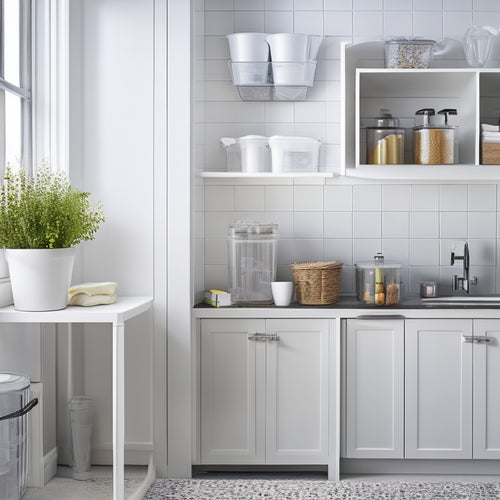
Revolutionize Fabric Storage With Creative Solutions
Share
As I tackle my fabric stash, I've discovered that creativity isn't just for crafting - it's also for storing it. I've revolutionized my fabric storage with solutions tailored to each fabric type, like color-coded bins for cotton and linen, and rolling up fleece to easily check colors and quantities. I've also repurposed everyday items, like mason jars and bookshelves, to maximize space. And by utilizing vertical space with wall-mounted shelves and hanging organizers, I've optimized my storage without cluttering my workspace. By embracing this creative approach, I've freed up space and sanity - and I'm just getting started on this organizational journey.
Key Takeaways
• Utilize fabric type-specific storage solutions, such as color-coded bins and hanging organizers, to keep fabrics organized and easily accessible.
• Repurpose everyday items, like mason jars and bookshelves, to create functional and space-saving storage solutions for fabrics.
• Maximize vertical space by using wall-mounted shelves, over the door storage racks, and pegboards to store fabrics and keep the workspace clutter-free.
• Implement creative folding and rolling techniques to store fabrics, such as rolling fleece fabrics for easy color and quantity checks.
• Protect delicate fabrics, like chiffon and silk, by storing them in airtight containers and hanging them to prevent wrinkles and creases.
Fabric Type-Specific Storage Solutions
How do I maximize my fabric stash's potential by tailoring my storage solutions to specific fabric types?
I've found that different fabrics require distinct storage approaches. For instance, I use color-coded organization and fabric bins for my cotton and linen fabrics, keeping them visible and accessible.
Fleece, on the other hand, is best rolled up and stacked, allowing for easy color and quantity checks. I store my felt fabrics in clear plastic containers, maintaining their shape and preventing creases.
Repurposing Everyday Items
By thinking creatively, I've discovered that everyday items can be repurposed to tackle specific fabric storage challenges, breathing new life into items that might've otherwise been destined for the trash. This approach not only reduces waste but also adds a personal touch to my fabric storage solutions. Here are some of my favorite repurposed items:
-
Old mason jars transformed into upcycled containers for storing small fabric scraps
-
Unused bookshelves converted into creative shelving for folded fabrics
-
Plastic bins repurposed for storing bulky fabrics like fleece and wool
-
Wooden crates upcycled into storage units for larger fabric pieces
-
Cardboard boxes reused as dividers for separating different fabric types in my storage units
Maximizing Vertical Space
I've found that maximizing my walls and ceiling is essential to storing my ever-growing fabric collection, as it allows me to keep everything organized without sacrificing precious floor or shelf space.
By utilizing wall-mounted shelves, I can store folded fabrics, keeping them visible and easily accessible. Over the door storage racks are also a great way to hang fabrics, freeing up space in my closet.
I've installed shelves that go up to the ceiling, making the most of my vertical space. This creative solution has allowed me to store a large quantity of fabrics without cluttering my workspace.
With everything neatly organized, I can focus on my next sewing project, feeling empowered and in control of my fabric collection.
Frequently Asked Questions
How Do I Prevent Fabric From Getting Creased or Wrinkled in Storage?
I prevent fabric from getting creased or wrinkled in storage by folding or rolling it neatly, using acid-free tissue paper or cloth dividers to reduce creasing, and storing them in breathable containers or shelves.
Can I Store Fabric in a Humid or Damp Environment?
I prefer to store my fabric in a desert than risk mold growth in a humid environment - it's a million times worse! To guarantee this, I maintain climate control with dehumidifiers and air conditioning, keeping my fabric storage space dry and mold-free.
How Often Should I Clean and Dust My Fabric Storage Area?
I schedule a seasonal purge to dust and clean my fabric storage area, ensuring forgotten corners don't accumulate dust, and I can maintain a pristine space that sparks creativity and productivity.
Are There Any Fabric Storage Solutions Suitable for Small Apartments?
As a fabric enthusiast in a small apartment, I opt for space-saving shelves and foldable racks to maximize storage, keeping my collection organized and easily accessible while minimizing clutter and optimizing my limited space.
Can I Store Fabric in Plastic Bins or Containers Long-Term?
"When in a pinch, I've used plastic bins for fabric storage, but I've learned the hard way: they're a recipe for disaster, as moisture buildup and pest control issues can ruin my stash in no time."
Conclusion
As I look back on my fabric storage journey, I'm thrilled to see how far I've come. With a little creativity, I've transformed my collection from chaos to calm.
Did you know that the average crafter has over 100 yards of fabric in their stash? By implementing these innovative solutions, I've not only tamed my own stash but also freed up space for new creations.
With a well-organized fabric collection, the possibilities are endless, and I'm excited to see what's next for my crafty adventures.
Related Posts
-

What Storage Solutions Work for Large Families?
You're likely drowning in clutter with a large family to manage. To regain control, start by maximizing space in smal...
-

Corner Solutions for Kitchen Cleaning Supplies
You can investigate corner solutions that improve access to cleaning supplies. This can be practiced by maximizing hi...

